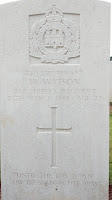 |
| The road leading to the memorial |
 |
| Gardeners maintaining the cemetery, a bunch of students in the background |
 |
| The buildings faintly visible in the background are in Johor, where Japanese came to Singapore from |
It is one thing to read from books about the different regiments that fought here. 8th Division of the 22nd Brigade sounds very real when one sees it inscribed on a headstone. It is hard to put my head around the many British Regiments that fought in the defence of Singapore. Here are examples, starting with the Australian forces.
Australia
 |
| Royal Australian Air Force |
 | |
| 2/18 Infantry Battalion (Australian Imperial Force) |
 |
| Royal Australian Naval Reserve |
Great Britain
 |
| Air Vice Marshal Pulford - Royal Air Force |
 |
| HMS Prince of Wales |
 |
| HMS Repulse |
 |
| HMS Sultan |
 |
| HMS Indomitable |
 |
| Royal Army Chaplain |
 |
| Army Catering Corps |
 |
| Royal Army Medical Corps |
 |
| Royal Army Ordnance Corps |
 |
| Royal Army Service Corps |
 |
| Royal Artillery |
 |
| The Border Regiment |
 | ||
| The Pioneer Corps |
 |
| 18th Reconnaissance Corps |
 |
| The Cambridgeshire Regiment |
 |
| The East Surrey Regiment |
 |
| The Gordon Highlanders |
 | ||
| The Leicestershire Regiment |
 |
| The Loyal Regiment |
 |
| The Manchester Regiment |
 |
| The Royal Norfolk Regiment |
 |
| The Royal Northumberland Fusiliers |
 |
| The Queen's Royal Regiment |
 |
| The Sherwood Foresters |
 |
| The Suffolk Regiment |
 |
| The Sutherland Highlanders |
 |
| The West Yorkshire Regiment |
Canada
 |
| Royal Canadian Air Force |
New Zealand
 |
| Royal New Zealand Navy |
 |
| Federated Malay States Volunteer Force |
 |
| Singapore Volunteer Corps |























